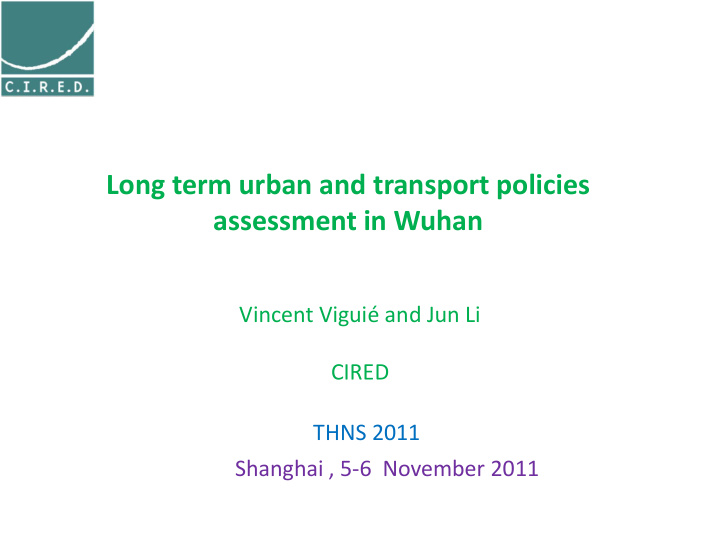



Long term urban and transport policies assessment in Wuhan Vincent Viguié and Jun Li CIRED THNS 2011 Shanghai , 5-6 November 2011
Background • Understanding the mechanism of urban expansion helps better govern the city • Future urban growth scenarios will allow us to design appropriate policies and measures to tackle urban pollution, UHI, urban sprawl, and climate vulnerability (floods, heat wave, storm…) • Implications for agricultural land use change and biodiversity degradation 2
Cities and climate change • Cities use more energy service provisions than rural • Substitute fossil fuels to biomass-fuel switch (typically in DCs like India and China) • Increased energy demand due to rise in income (recall the rural-urban income gap) • How the city will grow matters for transport infrastructure development and energy and environmental policies 3
4
Why study the city of Wuhan • A large economic powerhouse in central China with more than 9 m inhabitants • A conurbation of three adjacent towns seperated by rivers Yangtse and Han – transports plan and development complicated by the rivers – Historical process of distribution of local residents and employment • Dramatic growth of urbanised area since 1990s • Wuhan local government is keen to develop low carbon city in the 12 th FYP 5
Historical spatial evolution 1990-2000 6
How we see the future matters • Long term vision of the evolution of supply of and demand for transport services • How the city is going to expand? • Where the new urbanised areas will be located? residents, firms, services and other facilities etc. • What will be the modal shift of urban inhabitants for home-work commuting and leisure purposes? • What implications for land use policy and transport infrastructures? And of course the GHG emissions and climate vulnerability (floods, UHI) 7
Research proposal • Robust analyses are necessary to advise decision makers • Model is a powerful too for scenario analysis to draw insightful conclusions • Application of NEDUM model in Wuhan to inform local authority in terms of climate change mitigation and transport planning • Developing methodology for quantifying urban transport related GHG emissions and financial support in collaboration with domestic and international stakeholders 8
Wuhan 9
Wuhan 10
Population density 11
Real estate prices 12
Urban and transport development guidelines for future development • 武汉市城市总体发展战略规划 Comprehensive strategy for urban development • 武汉市城市总体规划( 1996-2020 年) Master Plan : 武汉市行政辖区,总面积为 8494 平方公里 • 武汉市城市轨道交通近期建设规划 (2010-2017 年 ) Rail transport planning • 《武汉市国民经济和社会发展第十二个五年总 体规划纲要》 12 th FYP of municipality of Wuhan 13
Target in the Master plan • 常住人口 Pop: 11.80 m by 2020 – 城镇人口 Urban area : 9.912 M – 主城区人口 Inner-city districts: 5.02M • 城镇化 Urbanization : ~84 % in 2020 – 2010 年 , 市域城镇建设用地面积控制在 795 平方 公里以内 – 2020 年 , 市域城镇建设用地面积 :1030 平方公里 以内 , 人均城镇建设用地面积为 104 平方米 14
Recommend
More recommend